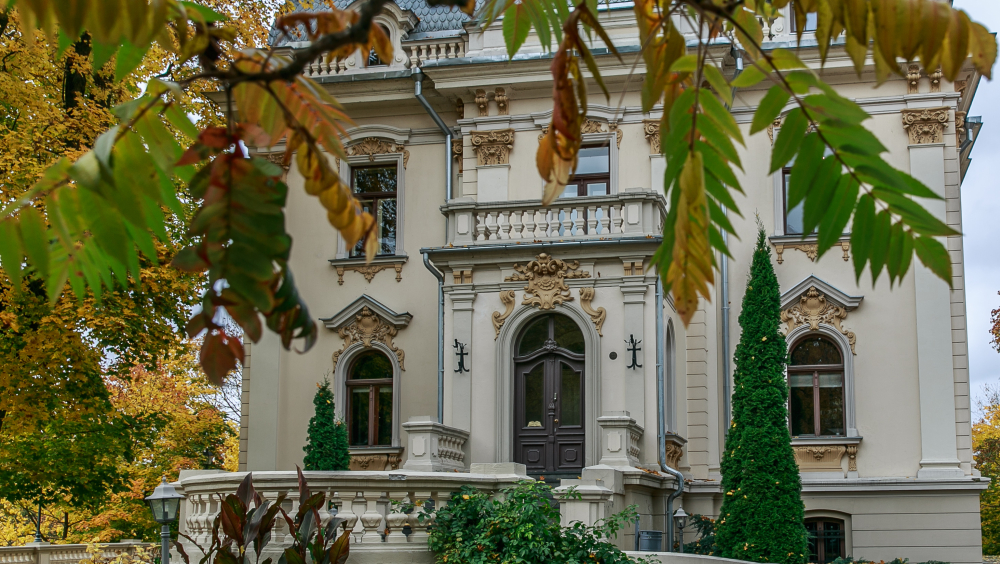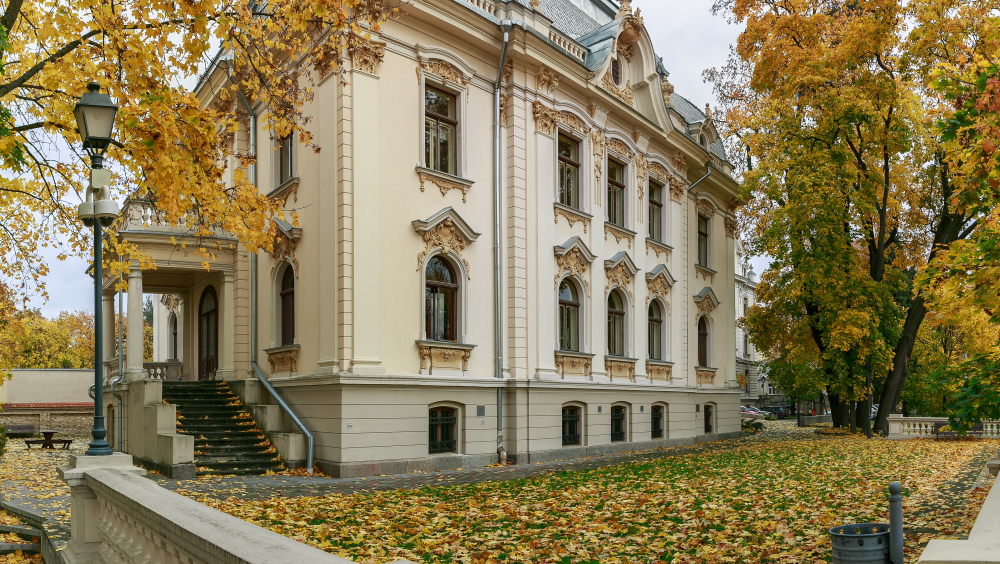The Tale of Vileišis Palace
A story of a grand house of Petras Vileišis that from its construction was destined to play a great role in Lithuanian culture revival.
If you would ask me what my favorite season is, I would say that it’s spring, when the chestnut trees are in bloom. Those majestic trees by the iron gates are as old as me and sometimes, when the street that is usually full of cars and people gets quiet, under the starlight dimmed by the lights of Vilnius we share our memories about the times that we witnessed passing by. However, during the winter I am left all alone as the trees are asleep, and I cannot help but to begin to feel lonely, with no one to talk to, no one to share my memories with. So, when this girl approached me and asked if I could tell my story, I found it quite peculiar. A human, interested in me, a building over a hundred years old? There are quite a lot of people who talk about me, both young and old, those who work here and those who just want to take a quick glance at the halls and rooms that I conceal with my thick walls. However, although they talk about me, they never talk to me, they never ask me. So, this is my chance to tell my tale. A story, that like a true fairytale involves gold, milk, a bit of danger and a secret. Or maybe even two.
People tend to start their stories with “I was born in…”. Well, I was built in 1906, although as a project by the exquisite architect August Klein I already existed on paper in 1904. The gentleman who is responsible for me coming to my existence was called Petras Vileišis. A talented engineer, one of the first Lithuanian self-made millionaires who picked a place in Vilnius, near the church of Saint Peter and Saint Paul. He wanted to create a stylish home for his family, so he spared no expenses, the whole construction cost around 250 000 gold rubles! If we would convert the sum, it would be around… Well, I am not sure, but a lot of euros! The whole process of me coming into life was full of innovations, such as using concrete or metal beam reinforced overlays. Even the stones for my foundations were brought from Finland! I am not bragging, but from the beginning I was equipped with electricity – still quite a rarity at those times. I was one of the few grand houses in Vilnius that had tap water as well as sewerage system with biofilter! With so much novelty involved, no wonder that while I was still being constructed a strange rumor started to spread that Mr. Vileišis is building his palace with cement mixed with… separated milk! I let that rumor fly around without trying to deny it, because what great house doesn’t want to have such legends?
Mr. Vileišis and his family moved in in 1906, however I got to enjoy their company only for two years… As the gentleman was extremely involved in the revival of Lithuanian culture, language, and history, he invested all his savings in a bookstore, the first Lithuanian newspaper (the loud and clunky press stood in one of the basements here!), a metalwork factory, not to mention his charity work… No wonder that the family soon was left with no money and the decision was made to move back to Russia and keep working there as an engineer. However, even during those short years with Mr. Vileišis I had my fare share of culture and attention: in 1907 I housed the first Lithuanian art exhibition, where such famous Lithuanian artists as Mikalojus Konstantinas Čiurlionis, Antanas Žmuidzinavičius, Petras Rimša displayed their works! More than 2000 people stepped over my threshold to attend the exhibition. I greeted lots of important people, some of them, like Doctor Jonas Basanavičius, the main figure in Lithuanian cultural revival, even lived here for quite some time. So, it is not a coincidence that some people believe that one of the copies of original Act of Independence of Lithuania is hidden somewhere in my walls. Or ceiling. Or floors. I could tell you if it’s true or not, but, as I mentioned before, what’s an old house without any secrets?
As you might guess, I survived all the wars and Lithuania’s occupations. However, once I was also on a brink of extinction! During the World War II, I housed German headquarters and when the retreat was imminent, they decided to… well, to blow me up. However, due to the clever actions and words of Pranas Razmukas, a librarian who at that time worked and lived here, I was saved, and all the explosives collected without harming anyone.
After the Vileišis family moved away, I became a center of Lithuanian history, language, and folklore. Later, as the decades changed, I was known as the Institute of Lithuanian Language and Literature. Currently I house the Institute of Lithuanian Literature and Folklore. Although Mr. Vileišis loved literature, nothing can compare with the numbers of books, manuscripts, journals, and magazines that are kept in my cellars and attics, every room and nook where a book can be put! Nothing calms me more than a gentle sound of pages being turned or seeing people absorbed in their work, their eyes catching every printed word. So, I would say that I am content as much as in the old days. I like people, hearing their dialogues, I like guests that come alone or in groups, sometimes there are concerts, plays, conferences that I get to see and hear (yes, the walls indeed have ears!). However, when the night comes, I am left alone, since nobody lives here anymore. Only a security guard keeps me company, making his rounds around the yard. It really feels lonely, especially now, when even during the daytime I get to see only a few people, many of the rooms stay locked, there are no conferences or other events. If we, buildings, are immune to things that I heard people call “pandemic”, they themselves surely are not. So, as I was approaching the end of my tale, the girl that was quiet all the time asked me if I would be against a thing called virtual tour. Somebody would come, take photographs of my interiors and later people could still visit me, not in person, as I understood, but via internet. They could read and even hear my story, explore the rooms that are usually closed to the public eye, see some of the valuable objects that I guard. I would be extremely happy if this could come true and you could visit me like this. As a house that was admired by many throughout the centuries (I know it from the letters and newspapers!), I would be glad to welcome all of you, curious souls, into a palace of Mr. Vileišis. And, as I end my tale here, let me tempt you with the second secret: if you visit me, I’ll show you chestnut trees that bloom even in winter.
So, when can we meet?
As Vileišis palace is one of the most prominent examples of Lithuanian Art Nouveau style, the greatest thing that could be done for this impressive complex of buildings is to make it more visible in European architecture context, where the said style gained immense popularity at the end of XIXth and at the beginning of XXth centuries. The buildings were planned and built with an important mission in mind, they were intended to become not only the home of Vileišis family, but also an important place for Lithuanian cultural revival, especially after the Lithuanian press ban (1865-1904), a place to strengthen Lithuanian identity with a clear orientation towards European values and democracy. The goal of me letting the house to tell its story is to make it known more widely than only Lithuania, as it is a cultural landmark that reflects many of the movements and shifts that took place in the continent at that time. If in the future it would be possible to open the house virtually, it would let many more people from all over to see all the interesting interior details, hear all the interesting facts and legends, and (re)connect the palace to the European net of Art Nouveau architecture, demonstrating the closeness of ideas, the connectedness of events through the visual aspect of culture.

